Laptops and tablets are so much more convenient than desktop computers for the very obvious reason of portability – you can’t (or certainly shouldn’t) lug a desktop PC between your home and office or on holiday with you.
The portable computer's limitation, though, is screen size and often a lack of ports to plug devices into. Some laptops have just one or two ports included as standard, and you need one of those for charging. And tablets have even fewer ports for device expansion.
There are plenty of people who prefer a mouse to the laptop’s trackpad, and even a full-size keyboard to tap away on – of course, there are Bluetooth keyboards and mice that don’t require a side port on the laptop.
The perfect setup would be a laptop for flexibility, plus one or more larger external displays, some USB ports for adding hard drives or a printer, and an Ethernet port so you can enjoy wired Internet access rather than flaky Wi-Fi.
The solution is a dock or docking station that includes all these ports and lets you connect your laptop or tablet to it with one cable.
Setup is simple. Just connect your laptop or tablet to the dock, and it instantly has access to all the dock's ports as if they were on the laptop itself - except to have that many ports, in reality, would make your laptop as thick as a brick.
In this review roundup, we’ll look at the best docks for USB-C laptops and tablets. Some laptops – notably Apple’s MacBook range – include a faster variant of USB-C called Thunderbolt 3 (TB3) or Thunderbolt 4 (TB4). Such laptops can use USB-C docks, but Thunderbolt’s higher bandwidth (40Gbps vs USB-C’s 5Gbps or 10Gbps) will be lost if not using a dedicated Thunderbolt dock.
Many docking stations are compatible with Apple's iPad Pro and iPad Air (4th Generation), and USB-C Windows tablets.
If you don't want a full docking station, just a handy USB-C adapter or dongle, check out our Best USB-C hub roundup. We've included a couple of "hubs" here because they're often cheaper but just as capable as docks.
Plain USB-C laptops won’t work with most Thunderbolt 3 or 4 docks, although there are a few reviewed here (from Caldigit and StarTech.com) that will work with both. That makes them a great choice for hot-desking and mixed workflow environments. Office IT doesn't have to buy different docks for different use cases – one dock can work on anything, and without adapters or drivers.
Thunderbolt laptops can use any of the USB-C docks reviewed here, but will lose some of their bandwidth and display advantages on the lower-spec docks.
Owners of Thunderbolt 3 or 4 laptops – such as Apple MacBooks (Air, and 13in, 15in and 16in Pro) – should also read Macworld's roundup of the best Thunderbolt 3 and 4 docking stations or our own best Thunderbolt 4 docks. The docks reviewed here mostly work with any TB3/TB4 laptops unless specified, but remember that if the dock is USB-C only, Thunderbolt laptops will not be using their full bandwidth for the fastest data-transfer speeds.
After our list of the best USB-C docks, we explain what each of the ports can do for you.
Anker PowerExpand Elite Dock
- 13 ports
- Thunderbolt and USB-C
- 85W PD
$299
- USB-C and Thunderbolt laptop compatible
- Compatible with USB-C Windows tablets and USB-C iPads
- Two Thunderbolt 3 ports (40Gbps) - one to host
- 85W PD charging, plus standalone charging
- Up to two external displays (2 x 4K at 60Hz; or 1 x 5K at 60Hz)
- 1 x HDMI 2.0 port (4K at 60Hz; or 1 x 5K at 60Hz)
- 2 x USB-C ports (10Gbps) - allows second 4K at 60Hz display with adapter
- 4 x USB-A ports (5Gbps)
- SD Card Reader (SD 4.0 UHS-II)
- microSD 4.0 Card Reader (SD 4.0 UHS-II)
- Gigabit Ethernet port for wired Internet access
- Front-facing 3.5mm Analogue Audio In & Out port
- 180W power supply
If you need more ports than the Caldigit USB-C HDMI or Pro Docks, Anker's PowerExpand Elite Thunderbolt 3 dock offers 13.
With its Titan Ridge chipset, it is also USB-C compatible, and is a neat and compact vertical dock.
The PowerExpand Elite can connect up to three external displays on Windows laptops only as macOS doesn't support MST (Multi-Stream Transport).
The HDMI and Thunderbolt/USB-C port would connect two displays (4K at 60Hz for Thunderbolt laptops), while the third external display would use one of the USB-C ports (4K at 30Hz). Unless your display has a USB-C connection itself, you’ll need an adapter (not included) using the Thunderbolt and USB-C connections.
One seemingly minor feature that we love is the easy-to-reach on-off switch, which will help save energy, prolong your device's battery, and stop the dock getting too warm when left unused overnight.
Both USB-C ports are Gen. 2 at 10Gbps, where some docks boast just 5Gbps C-type ports.
Caldigit USB-C HDMI Dock
- Thunderbolt and USB-C
- two HDMI ports
- 94W PD
Cons
- No downstream Thunderbolt port
$259.99
- USB-C and Thunderbolt laptop compatible
- Compatible with USB-C Windows tablets and USB-C iPads
- 1 x Thunderbolt 3 / USB-C port to host
- 94W PD charging, plus standalone charging
- 2 x HDMI 2.0b ports (dual 4K at 60Hz to T3 laptops; or dual 1080p or a single 4K at 30Hz display to a USB-C laptop)
- 3 x USB 3.2 Gen. 1 Type-A ports (5Gbps)
- 1 x USB 3.2 Gen. 2 Type-C ports (10Gbps) port
- SD Card Reader (SD 4.0 UHS-II)
- Gigabit Ethernet port for wired Internet access
- Front-facing 3.5mm Analogue Audio In & Out port
- 150W power supply
- While it's called a "USB-C" dock, Caldigit's USB-C HDMI Dock is compatible with Thunderbolt 3 and 4 laptops, and any USB4-certified device.
This modern docking station uses the latest Thunderbolt 3 chipset called “Titan Ridge”, which allows the dock to work on both Thunderbolt 3 and USB-C. Normally USB-C laptops can't use Thunderbolt 3 docks. T3 laptops can use USB-C docks but at a reduced bandwidth - USB-C runs at 5-10Gbps, but T3 at 40Gbps.
This flexibility means that Thunderbolt 3 laptops get to use all their bandwidth while USB-C laptop owners can use the same dock, and not have to buy a plain USB-C docking station. And since it works with USB-C, it can turn an iPad Pro or USB-C Windows tablet into a full computer experience since it can charge the tablet, connect a 4K monitor, keyboard, mouse and hard drives.
The USB-C HDMI Dock has two built-in HDMI connectors for directly adding dual 4K (at 60Hz if using a Thunderbolt 3 laptop) monitors to your laptop without the need for any USB-C Video Adapters. USB-C laptops can run dual displays at HD (1080p) or a single 4K monitor at 30Hz.
If you want to connect a DisplayPort display, the similar Caldigit USB-C Pro Dock is a very close match but with DP instead of HDMI.
Unlike most USB-C docks, the USB-C HDMI Dock also charges at 94W, enough for most top-end laptops. The DisplayPort USB-C Pro model is slightly less powerful at 85W.
Standalone charging functionality allows the dock to charge USB devices, such as a phone, tablet or smartwatch, at up to 7.5W without the laptop connected.
This is a great USB-C dock in its own right, and the T3/T4/USB4 compatibility is a future-proof and mixed-environment bonus.
Read our full Caldigit USB-C HDMI Dock review
Caldigit USB-C HDMI Dock
- Thunderbolt and USB-C
- two DisplayPort ports
- 94W PD
Cons
- No downstream Thunderbolt port
$249.95
- USB-C and Thunderbolt laptop compatible
- Compatible with USB-C Windows tablets and USB-C iPads
- 1 x Thunderbolt 3 / USB-C port to host
- 94W PD charging, plus standalone charging
- Up to two external displays (4K at 60Hz)
- Two DisplayPort 1.2 ports (4K at 60Hz)
- Three USB-A ports (5Gbps; one at 7.5W)
- One USB-C port (10Gbps)
- SD Card Reader (SD 4.0 UHS-II)
- Gigabit Ethernet port for wired Internet access
- Front-facing 3.5mm Analogue Audio In & Out port
- 150W power supply
CalDigit’s USB-C Pro Dock, like the company's USB-C HDMI Dock, uses the Titan Ridge chipset, and so works with both fast Thunderbolt and USB-C laptops.
Instead of HDMI, it features dual-DisplayPort display connectors, so there's no need for adapters if both your external monitors use that standard.
The two DisplayPort connections do away with the need for a USB-C to DP/HDMI that you get with docks boasting just one dedicated video option, and it also leaves the fast 10Gbps USB-C port spare for further device connections.
Read our full CalDigit USB-C Pro Dock review
Plugable's USB-C Triple Display 4K Docking Station
- 12 ports
- Three display ports
Cons
- Not for Macs
$279.99
- USB-C laptop compatible (works with Thunderbolt laptops at lower bandwidth)
- Compatible with USB-C Windows tablets
- USB-C to the host (5Gbps)
- 60W PD charging
- 2 x DisplayPort 1.2 (dual 4K at 60Hz to USB-C and T3 laptops)
- 1 x HDMI 1.2 (4K at 30Hz to USB-C and T3 laptops)
- 4 x USB-A (5Gbps); 1 x USB-C (10Gbps)
- Gigabit Ethernet
- 2 x 3.5mm Analog Audio In & Out
- 100W power supply
Plugable's USB-C Triple Display 4K Docking Station (UD-ULTC4K) does what its name says it can – it is stuffed full of fancy technology that enables it to run three external displays from a USB-C laptop, with two at full 60Hz 4K.
It uses a combination of USB-C DisplayPort Alternate Mode ("Alt Mode") for the HDMI port and DisplayLink USB graphics for its two DisplayPorts.
This brings with it some complexity and compatibility issues on certain versions of the macOS, but with some driver installed, all should be well.
Aside from the display wizardry, as a dock, it's a little underpowered – with just a 5Gbps USB-C 3.1 Gen.1 connection to the laptop. That will seriously downgrade a Thunderbolt 3 laptop's bandwidth, and we'd have preferred 10GBps for USB-C laptops.
But you'll be buying this dock for its triple-display or dual 60Hz 4K capabilities over USB-C.
Read our full Plugable USB-C Triple Display 4K Docking Station review
Kensington SD5700T Thunderbolt 4 Docking Station
- Thunderbolt 4
- 11 ports, inc 4 TB4
Cons
- 4.5W USB-A ports
$369.99
- One upstream Thunderbolt 4 port (40Gbps, 90W PD)
- Three Thunderbolt 4 downstream ports (40Gbps, 15W)
- Three USB-A ports (10Gbps, 4.5W)
- One USB-A port (480Mbps, 7.5W)
- Gigabit Ethernet
- SD Card Reader (SD 4.0 UHS-II)
- Front-facing 3.5mm Analogue Audio In & Out port
- 180W power supply
The Kensington SD5700T Thunderbolt 4 Docking Station gives you everything a dock should and is compatible with the latest Thunderbolt 4 connection standard, which is itself backwards compatible with Thunderbolt 3 and USB-C – so offers the best of all worlds.
If your laptop has Thunderbolt 4 ports, it's best to connect to a ThB4 dock such as this one.
At 180W, the power supply is the highest we've seen in all our hub and dock tests – great if you are powering multiple devices connected to the dock.
Read our full Kensington SD5700T Thunderbolt 4 Docking Station review
HyperDrive GEN2 12-Port USB-C Hub
- 12 ports
- Three display ports
Cons
- Limited for Macs
$149.99
- USB-C laptop compatible (works with Thunderbolt laptops at lower bandwidth)
- Compatible with USB-C Windows tablets and USB-C iPads
- 85W PD charging via 1 x USB-C port
- USB-C to the host
- 2 x HDMI (4K at 60Hz)
- DisplayPort 1.4 (4K at 60Hz)
- 2 x USB-A port (10Gbps)
- 2 x USB-A ports (480Mbps)
- SD Card Reader (SD 4.0 UHS-II)
- microSD Card Reader (SD 4.0 UHS-II)
- Gigabit Ethernet port
- 3.5mm Analog Audio In & Out
USB-C comes in several flavours, based on speed and bandwidth: from Gen1 5Gbps standard to 10GBps Gen2.
The HyperDrive Gen2 USB-C Dock represents great value, bristling with 12 ports. You'll need to bring your own USB-C wall charger (up to 100W), though, as there's no power supply with this docking station.
It uses the pro-look compact metal form factor beloved of Thunderbolt 3 docks, but takes that level of multiple-port flexibility to the world of USB-C.
Two of its USB-A ports support 10Gbps bandwidth, but the other two are the far more lowly 480Mbps USB 2.0.
Video options are plentiful (two HDMI and one DisplayPort) but Mac users should remember that over USB-C they can have just the one external display unless they download third-party DisplayLink drivers.
Twelve South StayGo USB-C Hub
- 9 ports
- Portable
- 85W passthrough power
Cons
- Ports a little underpowered
$99.99
- USB-C laptop compatible (works with Thunderbolt laptops at lower bandwidth)
- Compatible with USB-C Windows tablets and USB-C iPads
- 85W PD charging, plus standalone charging
- USB-C to the host (5Gbps)
- 1 x HDMI 1.2 (4K at 30Hz or full HD)
- 3 x USB-A (5Gbps; one with 7.5W BC 1.2 charging)
- 1 x USB-C (for charging)
- SD Card Reader (UHS-I)
- microSD Card Reader (UHS-I)
- Gigabit Ethernet
- 100W power capacity
This lightweight and compact USB-C dock undersells itself by calling itself just a hub. The Twelve South StayGo really a very capable portable dock that will fit in your pocket.
Yes, it doesn't have its own power supply, but you can connect it to your laptop's charger (or another) for passthrough charging at up to an impressive 85W.
It has HDMI for connecting an external display (4K at 30Hz), three USB-A ports (one of which you can use to charge your phone), SD Card reader for adding simple and inexpensive backup storage, and Gigabit Ethernet - all the basic and more.
It even comes with its own neat, short travel USB-C cable stored for protection, and ships with a 1m USB-C cable for normal desktop use.
Read our full Twelve South StayGo USB-C Hub review
Caldigit USB-C SOHO Dock
- Portable
- fast USB ports
- 60Hz 4K
- 100W passthrough power
$99.99
- USB-C laptop compatible (works with Thunderbolt laptops at lower bandwidth)
- Compatible with USB-C Windows tablets and USB-C iPads
- 100W passthrough charging
- 10Gbps USB-C to the host
- 1 x DisplayPort 1.4 & 1 x HDMI 2.0 (single 4K display at 60Hz; or dual 4K at 30Hz)
- 1 x USB-C (10Gbps)
- 1 x USB-A (10Gbps)
- 1 x USB-C Power Delivery
- SD Card Reader (UHS-II)
- microSD Card Reader (UHS-II)
Caldigit has done it again with its tiny SOHO (Small Office Home Office) Dock that beats other USB-C docks by supporting an external 4K display at 60Hz, rather than the lower-quality 30Hz limitation usually found with USB-C.
It achieves this by using separate lanes for both video and USB – meaning it can provide a consistent 4K 60Hz display while offering 10Gbps USB performance.
Yes, 10GBps. The SOHO Dock features the fastest USB ports you'll find: both the USB-A and USB-C ports are rated at 10Gbps bandwidth, compared to most docks that have such ports at 5Gbps.
It also comes with both DisplayPort and HDMI ports for flexibility when adding an external display to your laptop.
The SOHO Dock doesn't have many USB ports compared to the equally portable Twelve South StayGo, but if you need just one of each and speed is important to you, then it's hard to beat.
As this dock doesn't come with its own power supply, power delivery to the laptop would be gained by attaching your wall charger to the dock, so depends on the charger's capability.
Read our full Caldigit USB-C SOHO Dock review
OWC USB-C Travel Dock E
- Portable
- 92W passthrough power
Cons
- Ports a little underpowered
$64.99
- USB-C laptop-compatible (works with Thunderbolt laptops at lower bandwidth)
- Compatible with USB-C Windows tablets and USB-C iPads
- 92W passthrough charging
- USB-C cable to the host (5Gbps)
- 1 x USB-C port (5Gbps)
- 1 x HDMI 2.0 (single 4K display at 60Hz)
- 2 x USB-A (5Gbps)
- Gigabit Ethernet
- SD Card Reader (SD 4.0 UHS-II)
- 100W maximum power
This portable USB-C dock has six ports, and boasts at least one of everything you should need. The E stands for Ethernet - a port missing from most USB-C adapters.
It connects to the laptop by a short 15cm cable. If you need a longer cable, you'd be better off with a dock without an integrated cable. But for travel purposes, a dock with its own cable saves you from carrying an extra one around with you.
The USB-C and USB-A ports are 5Gbps; you will find 10Gbps USB and more such ports on some docks but not in this compact size.
The pass-through charging is impressive at 92W, and you have the option of using the laptop's bus power if you don't have a wall charger to hand or access to an outlet.
It weighs just 174g (6.1oz) and is compact enough to fit in a trouser pocket. When you're not travelling, it is great for taking up very little desk space.
PNY All-in-One USB-C Dock
- Portable
- 100W passthrough power
- VGA
$74.99
- USB-C laptop compatible (works with Thunderbolt laptops at lower bandwidth)
- 100W passthrough charging
- 5Gbps USB-C to the host
- 2 x 5Gbps USB-C (one PD)
- 1 x HDMI 1.2 (single 4K display at 30Hz)
- 1 x VGA (single 1080p display; 1920x1200)
- 2 x USB-A (5Gbps)
- Gigabit Ethernet
- SD Card Reader (UHS-I)
- microSD Card Reader (UHS-I)
- 100W maximum power
The portable PNY All-in-One USB-C Dock is compact (12-x-7-x-1.4 cm) and super lightweight, offering connection to one external display via either HDMI or VGA.
It packs its own short, integrated USB-C cable, making it a one-stop tool for your connection requirements, and no need to bring a separate cable to connect to your laptop.
Compared to other travel docks, it’s noticeably lighter (107g vs 151g), and a little shorter but an equal amount longer.
It matches well on ports and power, although the Twelve South StayGo has one more USB-A port, and its SD and microSD cards can be read simultaneously while the PNY can read one card at a time – which will rarely be a problem for most users.
It does boast a VGA port, which might come in useful with older displays or projectors.
We do prefer the StayGo’s two included cables (although neither is integrated), as one offers a handy 1m length compared to the PNY’s fairly meagre 12cm.
That said, its extreme lightness and VGA may well tempt those who travel to multiple destinations with mixed display options.
Read our full PNY 9-in-1 Mini Portable USB-C Hub review
Lention USB-C Docking Station
- Design
- Three display ports
- 100W passthrough power
Cons
- Not for Mac
$119.99
- USB-C laptop compatible (works with Thunderbolt laptops at lower bandwidth)
- 100W passthrough charging via USB-C (requires wall charger)
- 5Gbps USB-C to the host
- 1 x HDMI (single 4K display at 30Hz)
- 1 x DisplayPort (single 4K display at 30Hz)
- 1 x VGA (single 1080p HD display)
- 2 x USB-A (5Gbps)
- 1 x USB-A (480Mbps)
- Gigabit Ethernet
- SD Card Reader (UHS-I)
- microSD Card Reader (UHS-I)
The Lention USB-C Universal Docking Station is designed to sit under your laptop, and so take up no extra desktop space. It also has a flap that makes it easy to rest a tablet, although not at the same time as the laptop.
It has three USB-A ports – one at USB 2.0's 480Mbps and the other two at 5Gbps USB 3.0. The spare USB-C port is for attaching a wall charger as the dock doesn't come with its own power supply. It can't be used to attach a different USB-C device.
What is special about this dock is its three varied video options: HDMI, DisplayPort and VGA. Windows PCs can connect to three external displays at the same time, although the resolution is then pegged back to 720p HD quality rather than 1080p or 4K, which is possible with fewer monitors attached.
Although possible on a Mac, using DisplayLink software, Lention doesn't recommend multiple displays for Macs, and when using two simultaneously on a Mac, only a Mirrored image is possible – so we wouldn't rate this dock for use with Macs when better docks are available.
But for Windows it is fine, as long as the computer supports DisplayPort Alternate Mode.
Moshi Symbus Q
- Wireless phone charging
- Compact
$169.95
- USB-C laptop compatible (works with Thunderbolt laptops at lower bandwidth)
- Compatible with USB-C Windows tablets and USB-C iPads
- 60W PD charging
- USB-C to the host (5Gbps)
- HDMI 2.0 (4K @ 30Hz, 1080p @ 60Hz)
- 2 x USB-A (5Gbps)
- Gigabit Ethernet
- Wireless phone charger
- 90W power supply
This is a small dock (11.6 x 7.2 x 3.2 cm) that has a neat trick we haven't seen on others - it doubles up as a Qi wireless charger for your phone!
This wireless charging supports iPhones at 7.5W and Samsung phones at 9W for fast charging. And it can charge through cases up to 5mm thick.
It doesn't have Audio In/Out but Bluetooth might suit you better than wired for sound anyway.
We found the Symbus Q to be a very stable compact docking station. It has a built-in, short cable so needs to be fairly close to your laptop.
There's also a model (just Symbus) that doesn't include Qi wireless charging, from Amazon.
HyperDrive GEN2 6-Port USB-C Hub
- Portable
- 85W passthrough power
- 60Hz 4K
$99.99
- USB-C laptop compatible (works with Thunderbolt laptops at lower bandwidth)
- Compatible with USB-C Windows tablets and USB-C iPads
- 85W PD charging
- USB-C to the host (10Gbps)
- HDMI (4K @ 60Hz)
- 1 x USB-A (10Gbps)
- SD Card Reader (UHS-II)
- microSD Card Reader (UHS-II)
This little USB-C hub is very solidly built. Its metal exterior is ridged to keep the dock cool.
While not overloaded with ports, its six cover the essentials: HDMI for an external display, a fast 10Gbps, a solitary USB-A port for one extra device, both SD and microSD Card readers (at full speed), a 3.5mm audio slot, and USB-C for power delivery up to an impressive 100W - enough for any high-end laptop.
Most notable is the HDMI connection that can handle 4K at 60Hz, unlike most USB-C docks.
There's no Gigabit Ethernet for wired Internet, so it's for Wi-Fi lovers only. The one USB-A port might be seen as stingy but for a portable USB-C dock, it's not for mass device connections.
Plugable USB-C & USB 3.0 Dual HDMI USB Docking Station (UD-3900C)
- USB-C and USB-A compatible
- Two HDMI
- Six USB-A
Cons
- No 4K display
£119
- USB-C and USB-A laptop compatible (works with Thunderbolt laptops at lower bandwidth)
- Compatible with USB-C Windows tablets and USB-C iPads
- No PD charging
- Hybrid USB-C and USB-A to the host (5Gbps)
- 2 x HDMI 1.3 (HD @ 60Hz)
- 2 x USB-A (5Gbps)
- 4 x USB-A (480MBps)
- 2 x Input and Output audio jacks
This “universal” USB docking station uses a 2-in-1 cable that means you can connect either to USB-A or USB-C systems. This makes it useful in hybrid, hotdesking office environments where older laptops (USB-A) might mingle with more modern ones (USB-C or Thunderbolt).
The Plugable UD-3900C dock features two HDMI 1.3 ports so you can connect more than one external display, although the maximum 2048-x-1152 resolution for each is not 4K.
Alongside these display connections at the back are four USB 2.0 ports (480Mbps) and Gigabit Ethernet. At the front are two faster 5Gbps USB-A ports and 3.5mm audio input and output jacks. All USB ports can charge at a rather weedy 2.5W, so this is not the dock for using to charge devices, and the 20W power supply means it won’t charge a connected laptop either, so you need a PD wall charger to your laptop attached at the same time.
It’s a handy docking station for hotdesking office spaces where there’s a mix of USB-A and USB-C laptops, but the low port speeds and lack of charging aren’t impressive enough specs for us to recommend this dock to users of Thunderbolt 3 or 4 laptops or USB-C-only users.
StarTech USB-C Multiport Adapter Mini Docking Station
- Three display ports options
Cons
- Limited to one external display
$127.99
- USB-C laptop compatible (works with Thunderbolt laptops at lower bandwidth)
- Compatible with USB-C Windows tablets and USB-C iPads
- 60W PD charging
- 10Gbps USB-C to the host
- 1 x DisplayPort 1.4 (single 4K display at 60Hz)
- 1 x HDMI 2.0 (single 4K display at 60Hz)
- 1 x VGA (single 1080p display)
- 2 x USB-A (10Gbps)
- Gigabit Ethernet
- 1 x USB-C Power Delivery
- 75W maximum power
If you need a docking station with flexible video options, this compact and portable dock boasts DisplayPort, HDMI and VGA ports.
It will connect just the one external display, but that can be using any of its three video ports.
It also boasts fast 10Gbps USB-A and USB-C ports, including the wraparound integrated cable connection that hooks up to your laptop or tablet.
Plug in your USB-C wall charger to get 60W laptop PD charging and 15W for the dock itself, or run the dock from your laptop's own power.
There are two USB-A ports and Gigabit Ethernet but no SD Card reader.
Read our full StarTech.com USB-C Multiport Mini Docking Station review
StarTech Thunderbolt 3 USB-C Docking Station
- Thunderbolt and USB-C
- two DisplayPort
Cons
- No downstream Thunderbolt 3
$357.99
- USB-C and Thunderbolt laptop compatible
- 60W PD charging, plus standalone charging
- USB-C (and 40Gbps Thunderbolt 3) to the host
- 2 x DisplayPort 1.2 (dual 4K at 60Hz to T3 laptops; or dual 1080p or a single 4K at 30Hz display to a USB-C laptop)
- 3 x USB-A (2x 5Gbps; 1 x 10GBps); 2 x USB-C (10Gbps)
- Gigabit Ethernet
- 3.5mm Analog Audio In & Out
- 65W power supply
Like the Caldigit Pro Dock, the StarTech Universal Thunderbolt 3 or USB-C Host Docking Station (TB3CDK2DP or TB3CDK2DPUE) can work with both T3 and USB-C laptops without limiting bandwidth.
It also shares the benefits of dual DisplayPorts. Thunderbolt 3 laptops can run two 4K 60Hz monitors (4,096 x 2,160), while USB-C Laptops can handle two HD displays (1080p) or one 4K 30Hz monitor (3,840 x 2,160).
The StarTech dock features one more 10Gbps USB-C port than the Caldigit Pro Dock.
It lacks an SD Card reader, and maxes out power at 60W (compared to CalDigit's 85W). This should be ample for most laptops but top-end laptops will charge more slowly. And the Caldigit dock has a much more powerful total power supply (150W vs 65W) so can charge other connected devices simultaneously.
Dell DA300
- Portable
- Dinky
- 60Hz 4K
Cons
- No passthrough power
$75
- USB-C laptop compatible (works with Thunderbolt laptops at lower bandwidth)
- USB-C cable to the host (no laptop PD charging)
- DisplayPort 1.2; HDMI 2.0; VGA; (4K @ 30Hz, 1080p @ 60Hz)
- 1 x USB-A (10GBps); 1 x USB-C (10Gbps)
- Gigabit Ethernet
- No power supply
Dell's DA300 Mobile USB-C Adapter is a much dinkier dock than most of the docks reviewed here. You could simply pop it in your pocket (it weighs 80g) and use both at home and away, although one at each location, pre-connected to your other devices, would make sense.
It comes with its own USB-C cable, and can rotate, so the ports you need closest are where you want them.
There's no power supply, so no PD charging. That means connected devices will take their power from your laptop - which can, of course, still be charged in a regular manner by its own charger.
That's why we prefer the Twelve South StayGo as our favourite portable USB-C dock, although you'll get higher frame rates on a 4K display with this dock.
Because it has a 10Gbps USB-C connection to the laptop, it can support 4K resolution at full 60Hz, with laptops that support DP1.3 and above with 4K displays. It will work with just about any display you are confronted with (DisplayPort, HDMI, USB-C, and even ye-olde VGA) so is great in the business person's briefcase for those tricky meeting room presentation situations.
And it's pretty cheap, too, if you can live without it charging your laptop while in use, and you don't need multiple external displays.
Useful ports on the dock
USB-C: First, you need to connect your USB-C laptop to the dock, which takes up one of the dock’s USB-C ports, unless the dock has its own attached cable. One of the docks we tested can also connect to USB-A laptops so is useful for mixed hotdesking environments.
Most docks feature extra USB-C ports to attach compatible devices or connect to a USB-C display. You can also buy a USB-C to HDMI or USB-C to DisplayPort adapter to use this extra port to add an external display; see below.
USB-C comes in either 5Gbps or 10Gbps bandwidth varieties. If data-transfer speed is important, look for a dock with a higher rating. USB speed ratings are numerous, so pay attention to the technical specifications.
Also look for docks with USB PD, which stands for Power Delivery – this is a key feature on a full docking station. And then match that with the wattage your laptop needs to charge at full power. Most Windows laptops require 60W, but some larger laptops are begging for as much as 85W. Docks that can handle that much charging power can be more expensive as they need a larger power supply.
If the dock doesn’t have PD, then it will be drawing power from your laptop to run the other devices – unless the dock features a USB-C port that allows for passthrough charging via a separate USB-C charger. The same will happen with PDs with a lower wattage than the laptop. An 87W laptop can be charged by a 60W USB PD, but at a slower pace.
(Windows PC users must check if their USB-C port is capable of laptop charging as not all PC manufacturers have added this functionality to their USB-C ports, limiting them to data or display only.)
We also list the total wattage of the power supply, as this will often allow the charging of connected bus-powered devices.
Thunderbolt: Looking exactly like USB-C, Thunderbolt is a much faster connection standard – certified at 40Gbps. Thunderbolt 4 is backwards compatible with Thunderbolt 3, and has some extra benefits such as smarter daisy-chaining and the ability for docks to include up to four TB4 ports.
Standalone charging: This means the dock can charge devices, such as a phone or tablet, even when the laptop is disconnected.
USB-A: This is the ‘old’ USB standard that’s still used by many devices, such as hard drives, memory sticks, and printers. Work out how many of these you need when selecting the right dock for you. Like USB-C, USB-A comes in different speeds: from a lowly 480Mbps to the most common 5Gbps and the latest speedy 10Gbps.
Display: You'll want to hook your laptop up to an external display for more screen space. Why not boost that 13in laptop screen to a 32in 4K monitor? Some external displays use USB-C, so you can connect via a laptop's spare port or via one on the dock. Most docks, however, include either DisplayPort or HDMI ports, or a mix of both; some include the old VGA standard. And you can attach USB-C to HDMI or USB-C to DisplayPort adapters, too.
Most dual-monitor setups allow for two displays at 1080p HD resolution, but the best high-resolution displays are 4K. 4K at 60Hz is the best for gaming and high-graphics performance, while 4K at 30Hz is good enough for more productivity-based tasks – but not as great as at that higher rate.
Non-Thunderbolt USB-C docks are mostly limited to 30Hz 4K but there are some that can support 60Hz on one external display.
Look out for the version of DisplayPort or HDMI, as the later versions have greater powers when it comes to higher resolutions and refresh rates.
HDMI 1.4: Supports up to 4K (3840-x-2160) at 30Hz, or 1080p HD at 120Hz.
HDMI 2.0: Supports up to 4K at 60Hz
DisplayPort 1.2: Supports up to 4K at 60Hz
DisplayPort 1.3: Supports up to 4K at 120Hz or 8K at 30Hz
DisplayPort 1.4: Supports up to 8K at 60Hz and HDR
Natively, USB-C struggles to handle 4K at 60Hz, so falls back to 30Hz as its maximum. Some companies have got around this by using DisplayLink driver, but this does mean you need to install extra software. And Caldigit's SOHO Dock uses separate lanes for data and video, and so can hit 60Hz on a 4K display.
For laptops that have only a 5Gbps USB-C port, 4K at 60Hz is out of the question. So check your laptop specs. (Thunderbolt laptops have no problem getting 4K at 60Hz even on two displays.)
Most mid- to high-end displays now have DisplayPort and HDMI built into the monitor, allowing users to choose the connector they want to use. The resolution is the same on HDMI and DisplayPort, but DisplayPort can be more stable and capable in certain situations. Read more on HDMI vs DisplayPort.
Note that Macs (except the latest M1 pro and M1 Max MacBook Pro models) support only one external display over USB-C (two over Thunderbolt), although you can get around this limitation by installing DisplayLink drivers.
Gigabit Ethernet: With an Ethernet port on the dock you can connect to wired Internet, which is usually much faster than Wi-Fi.
SD or Micro SD Card Reader: We usually think of these as camera memory/storage cards, and one of these reader ports will allow you to quickly slip in your photo-laden card for immediate access from your laptop. However, more usefully, SD or Micro SD Cards are also an incredibly inexpensive way of adding portable storage to your laptop. Take a look on Amazon for affordable SD and Micro SD Cards (Amazon UK or Amazon US), where you can buy 256GB for around £30 or $40. Adding that amount of storage to a laptop would normally cost you around £150.

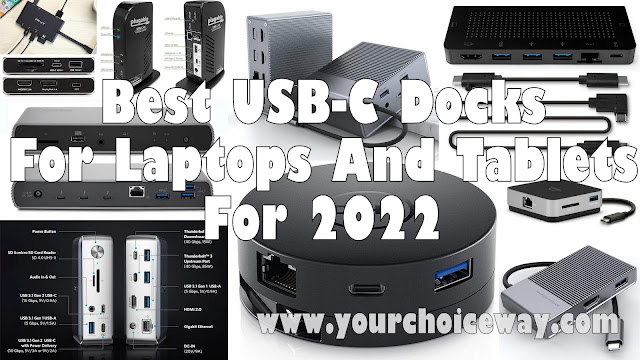

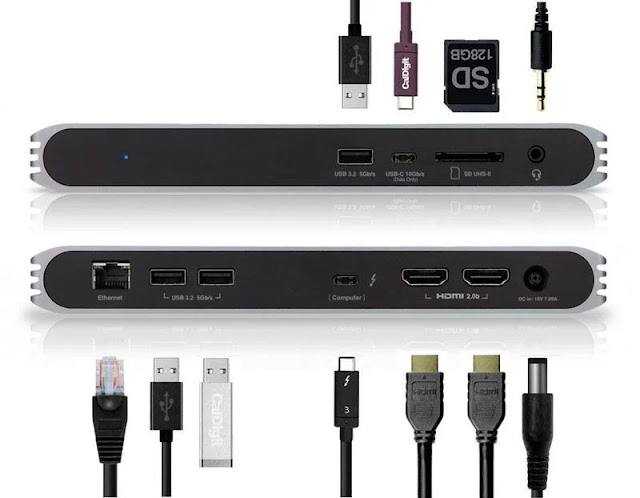
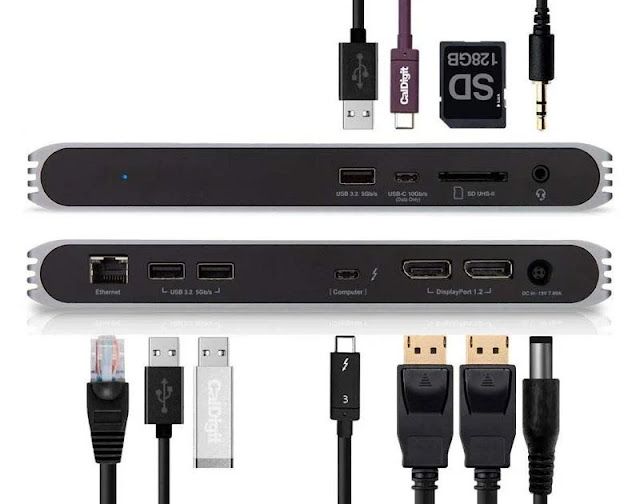
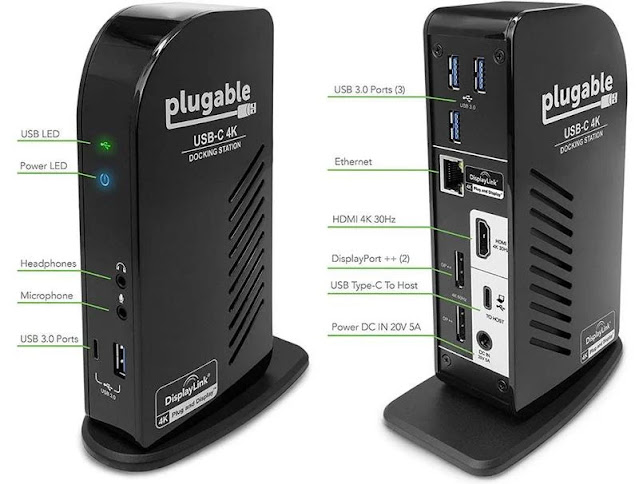
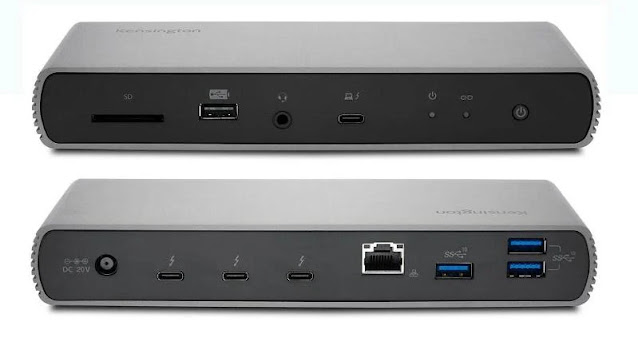
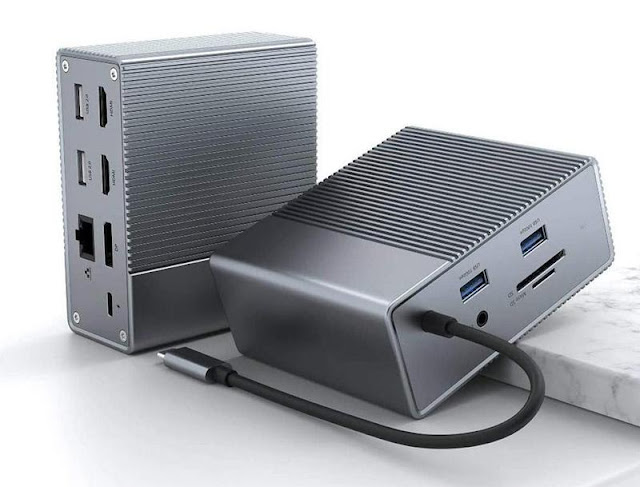
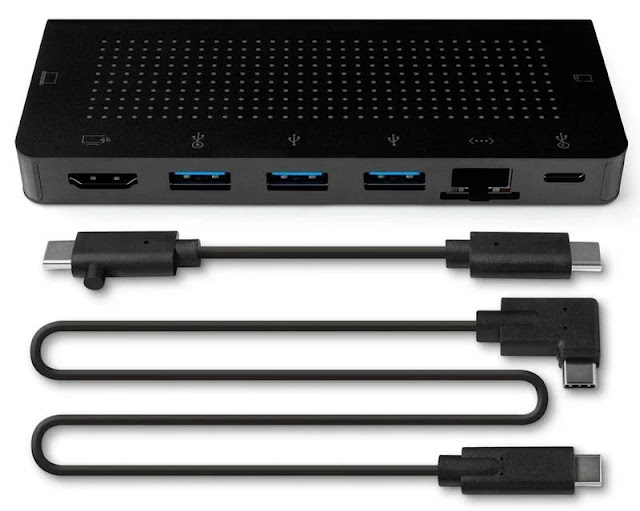


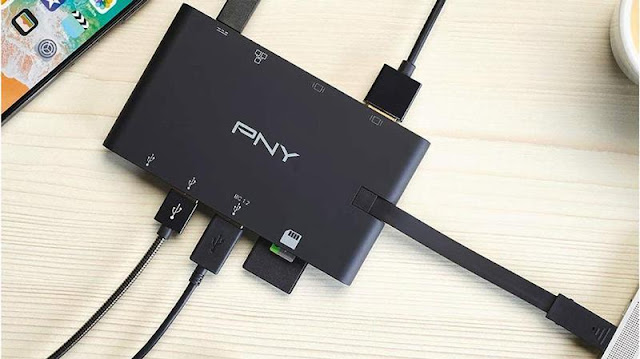



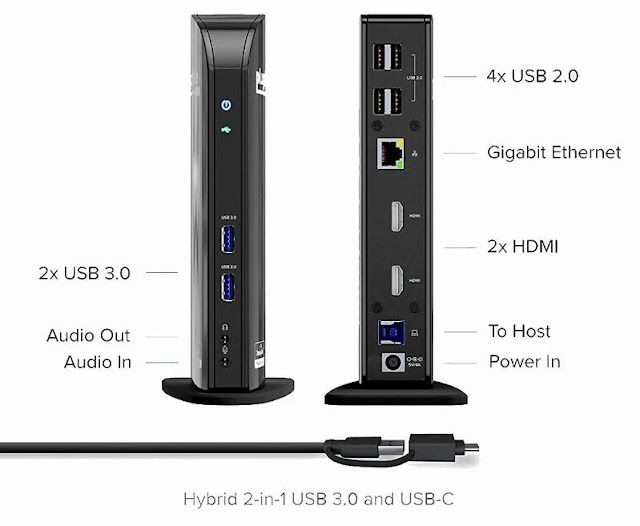
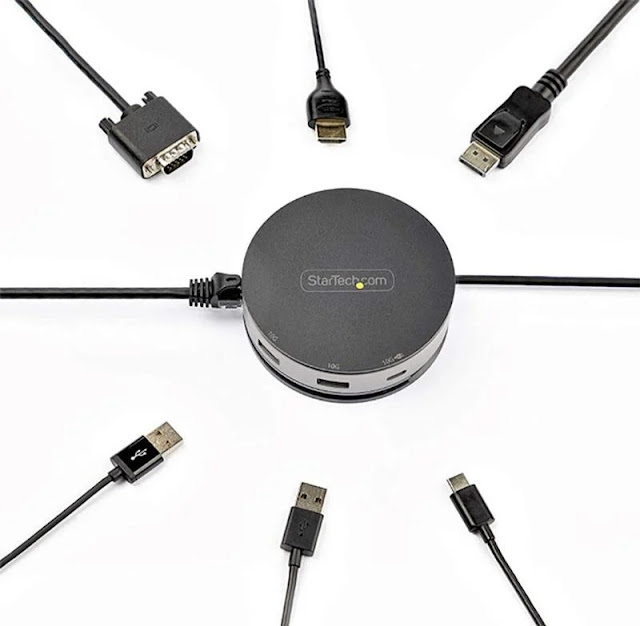



0 comments:
Post a Comment